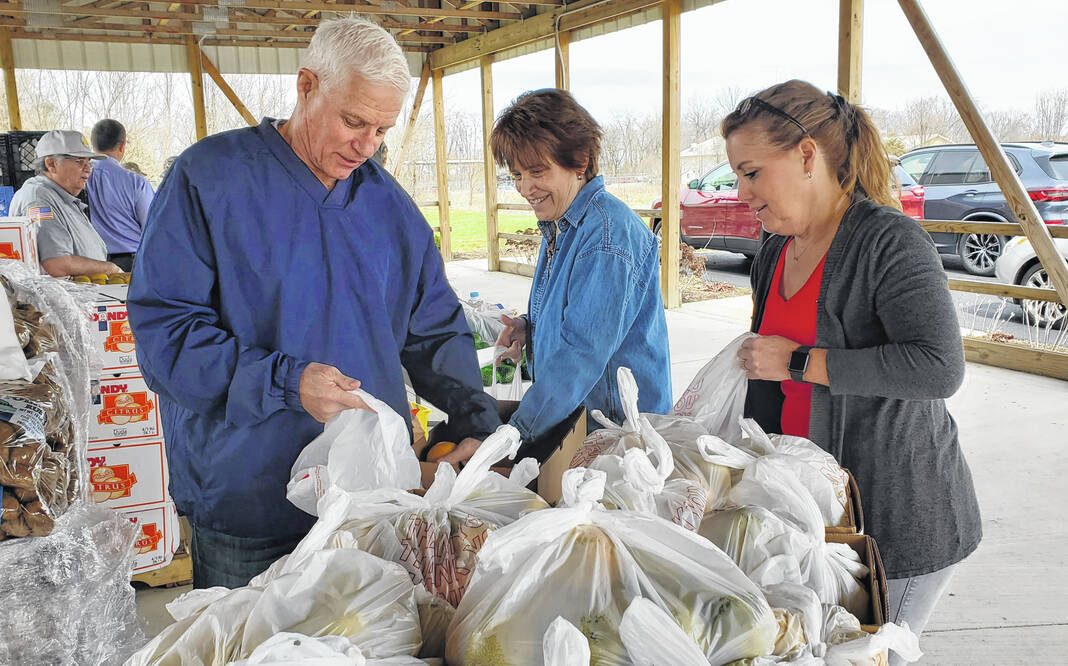
At PIN’s March 2022 Produce Market, volunteers Steve Reymann, Liane Hartsook, and Michele Noss prepare some of the 10,000 pounds of donated fruit and vegetables distributed to those in need.
Submitted by People in Need, Inc.
People In Need, Inc. of Delaware County Ohio (PIN) is preparing for an increase in services following the end to the emergency allotments to Ohio’s Supplemental Nutrition Assistance Program (SNAP). Since March 2020, households receiving SNAP benefits have seen additional funding each month, but the final emergency allotment will be made at the end of February.
Future benefits will be drastically reduced from current levels. SNAP, for which both employed and unemployed Ohioans qualify, has awarded the maximum amount available to those using the program throughout the pandemic. An individual who qualifies for SNAP currently receives $281 in food assistance every month as a result of the emergency allotments, and a family of four $1,034. That assistance could be reduced to as little as $23 and $180 a month, respectively, in March. This comes amid 12% price increases at the grocery store, creating a scenario which could prove particularly harmful to older Americans.
“I don’t know how people are going to manage with such a drastic change. Inflation and increasing food costs make this even worse on top of other living expenses. If you search for an apartment right now, you’re not going to find much of anything for less than $1,000 a month, the more affordable options just aren’t showing up anymore,” said Kathy Hoff, PIN’s executive director. “This loss of support is going to have a domino effect on everyone’s finances. As they pour more of their money into food, they’re going to have less and less to spend on housing, utilities, clothing, everything. This isn’t a loss of something extra; you need food to survive.”
Hoff went on to explain that in addition to the increase in traffic for PIN’s food insecurity programs, the organization expects to see more requests for their emergency services.
“When you have to stretch a dollar, you can only pull so hard before it tears. Food is immediate, and if it’s a choice between food and paying your electric bill, you’re going to go buy groceries, feed your kids every time. When that utility gets shut off, PIN can assist and get it turned back on, but that pulls even more from our own resources.”
In Ohio, about 13% of residents utilize SNAP, formerly known as food stamps, to supplement their buying power. In Delaware County, nearly 23,000 residents have been identified as food insecure, but only about a fourth of them fall within SNAP qualifications of 130% of the Federal Poverty Level, according to Feeding America. That means that a household of one must have an annual income of $17,667 and a household of four $39,000 or less to receive SNAP benefits.
Hoff explained that the food insecurity programs at PIN operate differently from SNAP’s guidelines.
“All of our programs can be utilized by Delaware County residents at or below 200% of the Federal Poverty Level. So, in that way, we reach a bit further into the hunger gap than other forms of assistance. A lot of these folks who can’t use SNAP already come to us instead, and that number is only going to grow.”
PIN reported that in 2022, 1,771 households utilized their Food Insecurity Programs over the course of 10,924 service events. Those service numbers increased 17% from 2021, even while SNAP beneficiaries still received the emergency allotments.
Currently, each family who visits PIN receives four days’ worth of groceries, based on their family size. This grocery supply includes canned goods, bread, fresh produce, and meat, available to qualified households up to once per week. Each visit takes less than five minutes once clients are checked in by one of PIN’s many volunteers.
That efficiency is out of necessity; in 2019, PIN reported an average of 50-60 services each week which could take up to 30 minutes to complete. That’s compared to a growth of up to 300 weekly services in 2022. PIN distributed nearly $1 million in contributed goods including food, cleaning supplies, personal care items, and holiday toys to those in need last year. These donated goods and food purchased with PIN’s funding fed 418,575 meals to Delaware County.
With benefits falling and costs rising, Hoff said that 2023 may be set to surpass those numbers.
“In the past, January and February have been slower months for our services. That trend has been broken this year,” she said. “Visits to our Food Pantry were up 42% the first half of February over 2022, and it’s only getting busier.”
Concern over the end of the SNAP emergency allotments is not unique to PIN, as many organizations in the area also brace themselves for an increase in requests for assistance.
Coupled with an increased difficulty in obtaining a variety of food groups and nutritious options through typical avenues, PIN has been working closely with partners to find new methods of maintaining the supplies they need.
“The gratitude and relief that we see on our neighbors’ faces every day truly keeps us going, even with the heavy workload,” says Hoff. “Not a day goes by that our staff and volunteers aren’t reminded about the difference this organization makes for so many people. Having a full fridge is such a relief in your time of need; it’s a small step, but one that we’re glad we can accommodate.”
Qualified Delaware County residents are encouraged to utilize PIN’s food assistance once per week on Monday, Wednesday, or Friday.
More information about PIN’s food insecurity programs and other services available can be found at DelawarePeopleInNeed.org.

